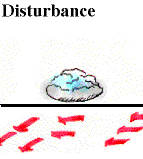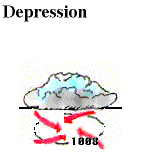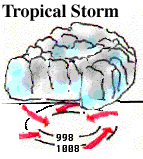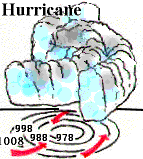
Though less fearsome than a full-fledged hurricane, tropical storm still are very powerful and often destructive weather systems, whose winds can cause millions of dollars in damage and whose rains can often turn torrential, inundating towns and cities with severe flooding.
While you've probably heard the term tropical storm mentioned in a forecast, usually in connection with a system that has graduated from a tropical depression and is on its way to becoming a hurricane. What exactly do these terms mean? What specifically, is a tropical storm and how is it different from a hurricane or a tropical depression?
Ok, let me answer the question in a simply way. a tropical storm is a type of tropical cyclone, one that has intensified enough to reach sustained wind speeds of at least 39 mph. Once it reaches this level of strength and intensity, a tropical depression becomes a tropical storm, and receives an official name from the National Hurricane Center.
Furthermore, it is at this point also that a tropical cyclone starts to take on the features we commonly associate with hurricanes, as its winds become stronger and more organized than those of a tropical depression and its rotation starts to take on a more circular shape.
Tropical storms represent the next-to-last phase of tropical cyclone development -- before a tropical cyclone officially becomes a named hurricane, it passes through four distinct stages: tropical disturbance, tropical depression, tropical storm and finally, hurricane (which is reached when a storm's sustained winds reach 74 mph or greater).
Heavy rain and flooding: Tropical storms biggest threat
Though they don't pack the same powerful winds that hurricanes do or at least not at the same intensity as a hurricane, tropical storms still bring nearly as great a threat from heavy rains and flooding to both coastal communities as well as areas far inland.
In fact, a storm that is classified as a hurricane for much of its life cycle may actually be downgraded to a tropical storm by the time it makes landfall. That doesn't mean it can't cause severe damage -- some of the most destructive named storms in U.S. history were tropical storms when they made landfall, and yet still caused dozens of deaths and hundreds of millions of dollars in damage to property and homes.
Here's we include a few of the most notable tropical storms to hit the U.S. coast in recent memory for you to know and gaining some knowledge..
Tropical Storm Claudette (1979)
Residents who have lived in the Houston, Texas, area since the late 1970s will no doubt have strong memories of Tropical Storm Claudette, which set a record for rainfall in a 24-hour period in the town of Alvin, near Houston -- an observer there reported 43 inches of rain in 24 hours, a United States record for a 24-hour rainfall amount, according to the National hurricane Center.
Claudette was first detected as a tropical wave that moved off the African coast on July 11. The wave spawned a tropical depression on July 16 that briefly became a tropical storm the next day as it approached the Leeward and Virgin Islands. Over the next couple of days, Claudette weakened back into a tropical depression and then regained tropical storm strength over the western Gulf on July 23 and made landfall the next day near the Louisiana-Texas border.
Claudette produced tropical storm conditions along portions of the Texas and Louisiana coasts, but the storm will be most remembered for its rainfall. Widespread amounts in excess of 10 inches occurred over portions of southeastern Texas and southwestern Louisiana, with several local amounts in excess of 30 inches.
The rains produced severe flooding that was responsible for one death and $400 million in damage. The storm also produced heavy rains over portions of Puerto Rico that were responsible for one death.
Tropical Storm Alberto (1994)
The hurricane season of 1994 was barely a month old when Tropical Storm Alberto deluged the Gulf coastline with heavy rains and severe floods in parts of Alabama, Florida and even into western Georgia, leaving an estimated 30 people dead and $500 million in damage across the storm-stricken areas.
Alberto was first detected as a tropical wave that moved off the African coast on June 18. By late June, the wave had moved into the western Caribbean and formed into a tropical depression near the western tip of Cuba on June 30. Now a full-fledged tropical cyclone, it moved northwest through July 1 as it became a tropical storm and then turned northward. This motion continued until Alberto made landfall in the western Florida Panhandle on July 4th and later moved north-northeastward into western Georgia, where it did a loop on the 5th and 6th. The cyclone finally dissipated over central Alabama on July 7.
Alberto's winds and tides produced only minor damage at the coast, but the excessive rains that fell in Georgia, Alabama, and western Florida were another story. Amounts exceeded 10 inches in many locations, with the maximum being the 27.61-inch storm total at Americus, Ga. (including 21 inches in 24 hours). Severe flooding resulted over large portions of southern Georgia, western Alabama, and the western Florida Panhandle.
Tropical Storm Allison (2001)
Known as perhaps the deadliest and costliest U.S. tropical storm on record -- responsible for 41 deaths and at least $5 billion in damage -- Tropical Storm Allison began life as an area of disturbed weather over the northwestern Gulf of Mexico on June 5, 2001, and later developed into a tropical storm.
The storm made landfall near Freeport, Texas later that day, though it weakened to a depression on the 6th while drifting northward. Allison then made a slow loop over southeastern Texas from the 7th through the 9th, and later moved into the Gulf of Mexico, where it acquired subtropical characteristics. It then moved east-northeastward over southeastern Louisiana on the 11th, where it re-intensified into a subtropical storm.
Allison weakened back to a subtropical depression on the 12th while continuing east-northeastward, and this motion carried it to southeastern North Carolina by the 14th where it again stalled. The cyclone drifted northward to northeastward drift over land on the 15th and 16th. This was followed by a faster northeastward motion on the 17th as the center emerged into the Atlantic. Allison regained subtropical storm strength later that day before becoming extratropical on the 18th southeast of Cape Cod. The system dissipated southeast of Nova Scotia the next day.
Allison brought tropical-storm-force winds and above-normal tides to portions of the Texas and Louisiana coasts. However, the greatest legacy of the cyclone was the widespread heavy rains and resulting floods along its path. The areas worst affected were Houston, Texas -- where the Port of Houston reported nearly 37 inches -- and a number of other locations where rainfall amounts reached more than 30 inches. The storm also spawned 23 tornadoes.
Source: National Hurricane Center






